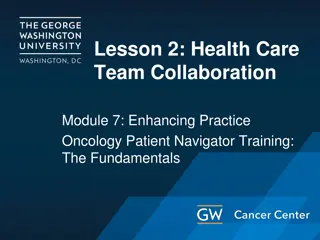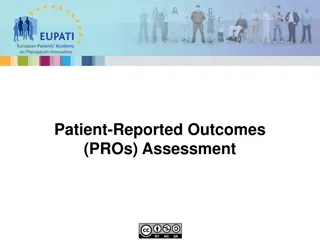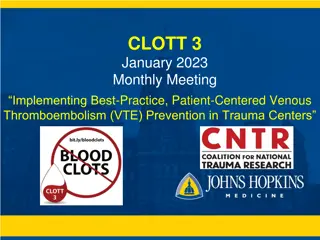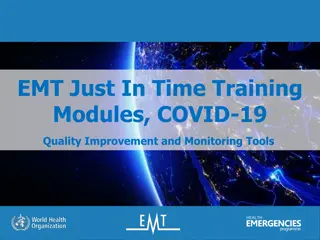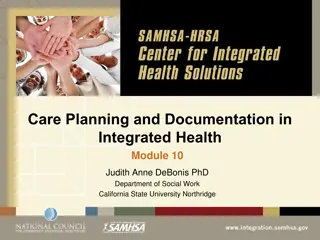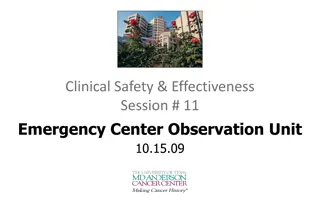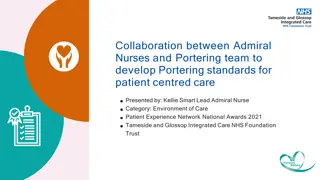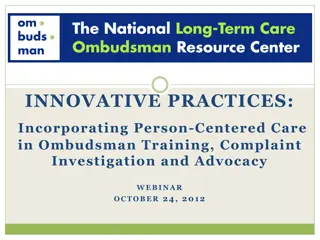Implementing MQii for Patient-Centered Care
Implementing the Malnutrition Quality Improvement Initiative (MQii) involves training project teams, understanding clinical workflows, and engaging patients in their care. Multidisciplinary project and care teams play essential roles in effective implementation, with patients and family caregivers considered integral members. The concept of patient-centered care is continuously evolving, with patients providing input on decisions related to their care. Empowering patients through education and counseling is a key aspect of the initiative.
- Patient-Centered Care
- MQii Implementation
- Clinical Workflows
- Multidisciplinary Teams
- Patient Empowerment
Download Presentation

Please find below an Image/Link to download the presentation.
The content on the website is provided AS IS for your information and personal use only. It may not be sold, licensed, or shared on other websites without obtaining consent from the author. Download presentation by click this link. If you encounter any issues during the download, it is possible that the publisher has removed the file from their server.
E N D
Presentation Transcript
This is an Example of the Main Title of a Presentation: MQii Implementation Training And This is Where the Subtitle Would Appear with More Info
Presentation Roadmap Review of Project Teams and Toolkit Resources 1 Understanding the Recommended Clinical Workflow 2 Training on Malnutrition Care Intervention 3 This is an Example of the Main Title of a Presentation: Next Steps 4 And This is Where the Subtitle Would Appear with More Info 2
This is an Example of the Main Title of a Presentation: and Toolkit Resources Review of Project Team Roles And This is Where the Subtitle Would Appear with More Info 3
Multidisciplinary Project and Care Teams Are Essential for Effective Implementation of the MQii The Project Team consists of demonstration leaders responsible for guiding overall execution of the intervention The Care Team is responsible for direct patient care o Given the consideration of patient-driven care throughout this demonstration, patients/family caregivers are considered an integral part of the Care Team This is an Example of the Main Title of a Presentation: And This is Where the Subtitle Would Appear with More Info Hospital Staff Non-Hospital Staff 24 4
Involvement of the Patient/Family Caregiver is an Essential Component of the MQii THE CONCEPT OF PATIENT-CENTERED CARE IS ONE THAT IS CONTINUOUSLY EVOLVING AS THE ROLE OF THE PATIENT BECOMES INCREASINGLY DEFINED Examples of patient-driven care deriving from the Toolkit include: Patient Patient Experience Experience Patient provides input on food and oral nutritional supplement decisions Patient Patient Engagement Engagement This is an Example of the Main Title of a Presentation: Patient-Centered Care Patient Patient Empowerment Empowerment Patient receives education and counseling regarding their conditions Patient-Driven Patient helps inform discharge planning And This is Where the Subtitle Would Appear with More Info Throughout the MQii, patients are expected to be informed participants in their care, helping to drive decision-making as a member of the Care Team. 5
MQii Implementation Aims to Improve your Hospitals Nutrition Care Processes and Associated Outcomes Implementation Objectives 1 Reduce clinical practice variability related to malnutrition care Provide a feasible and usable malnutrition quality improvement toolkit that can be easily deployed by a multi-disciplinary care team in an acute setting 2 This is an Example of the Main Title of a Presentation: practices for optimal malnutrition care delivery 3 Improve knowledge of the importance of malnutrition and best And This is Where the Subtitle Would Appear with More Info Impact clinical outcomes of average length of stay and 30-day all- cause readmissions as surrogates for the cost of care 4 6
Care Team Leadership Is Critical for Driving Results Objective #1: Reduce clinical practice variability 1. Support changes and enhancement to clinical care practices Support use of recommended clinical workflow for optimal nutrition care by ensuring timely and consistent care of malnutrition care best practices Your Role This is an Example of the Main Title of a Presentation: care team members track this information 2. Serve as leaders in change management and help care team members meet initiative goals and data collection requirements Be familiar with quality indicators used and help monitor how 3. Ensure that conducted workflow mapping is an accurate reflection of actual current practices And This is Where the Subtitle Would Appear with More Info 4. Confirm target areas for clinical improvement and methods for implementation * Also a Learning Collaborative research question 7
Care Team Leadership Is Critical for Driving Results Objective #2: Provide a feasible and usable malnutrition quality improvement toolkit 1. Support implementation and assessment of the toolkit 2. Be familiar with toolkit strategies help ensure implementation of recommended care workflow This is an Example of the Main Title of a Presentation: 4. Participate in regular team meetings and share information on barriers or challenges and successes of implementation Your Role 3. Provide your feedback on implementation of this initiative by sharing thoughts on ease of use and relevance for changing care practices And This is Where the Subtitle Would Appear with More Info * Also a Learning Collaborative research question 8
Care Team Leadership Is Critical for Driving Results Objective #3: Improve levels of malnutrition 1. Understand importance and impact of malnutrition on patient outcomes and associated costs 2. Help educate other care teams of this importance and strategies for improving malnutrition care This is an Example of the Main Title of a Presentation: Your Role And This is Where the Subtitle Would Appear with More Info * Also a Learning Collaborative research question 9
Care Team Leadership Is Critical for Driving Results Objective #4: Impact clinical outcomes of average length of stay and 30-day all-cause readmission rates 1. Help oversee care team documentation of accurate clinical care practices 2. Help reduce these rates by improving quality of malnutrition care as recommended by MQii strategies This is an Example of the Main Title of a Presentation: Your Role And This is Where the Subtitle Would Appear with More Info * Also a Learning Collaborative research question 10
This is an Example of the Main Title of a Presentation: Nutrition Care Interventions Training Your Care Team on And This is Where the Subtitle Would Appear with More Info 11
Reviewing Existing Workflow Processes Will Help Identify Where Quality Improvement is Most Needed Your MQii Project Team should complete the following activities to guide MQii implementation: Create a workflow map of existing care practices to address malnutrition among admitted adults Compare your current workflow processes to recommended care practices This is an Example of the Main Title of a Presentation: identify where improvement efforts are needed Identify areas in your facility s nutrition workflow to And This is Where the Subtitle Would Appear with More Info 12
There Are Seven Key Components in the Recommended MQii Nutrition Care Workflow 1. Malnutrition Screening Systematic process of identifying an individual who is malnourished or who is at risk for malnutrition to establish whether a patient needs a nutrition assessment 2. Nutrition Assessment Systematic approach to collect and interpret data from patients and family caregivers to determine a malnutrition diagnosis and severity of malnutrition 3. Malnutrition Diagnosis Documentation of a patient s nutrition problem that requires independent treatment using standard taxonomy (e.g., ICD-10) in the patient s medical record 4. Malnutrition Care Plan Development of comprehensive planned actions to address nutrition- related factors affecting patient health status 5. Intervention Implementation Implementation of specific actions outlined in the malnutrition care plan 6. Malnutrition Monitoring and Evaluation Track progress made since malnutrition diagnosis and assess whether nutrition outcomes/goals are being met This is an Example of the Main Title of a Presentation: And This is Where the Subtitle Would Appear with More Info 7. Discharge Planning Determines a patient s appropriate post-hospital requirements for nutrition services or nutrition care. This should include documentation of nutrition diagnosis, status, and orders in discharge plan. 16 13
Training for Malnutrition Screening Conduct Malnutrition Screening Recommended to occur within 24 hours of patient admission Timing: Responsible Care Team Member: Nurse or qualified care team member Recent weight loss Decreased appetite Height Weight Clinical Data to Collect/Record:* This is an Example of the Main Title of a Presentation: For at-risk patients, refer immediately for nutrition consult and assessment For patients at risk during screening, expedite nutrition intervention within 24 hrs with food or ONS Score patient to determine risk and document results Key Steps: And This is Where the Subtitle Would Appear with More Info Key Decision Point: If the patient is determined to be at risk for malnutrition from either the initial or secondary screening test during hospital stay, a nutrition assessment is needed *Validated tools for data collection of malnutrition screening include: Birmingham Nutrition Risk (BNR), Maastricht Index, Malnutrition Screening Tool (MST), Malnutrition Universal Screening Tool (MUST), Mini Nutrition Assessment (MNA), Nutrition Risk Classification (NRC), Nutritional Risk Index (NRI), Nutritional Risk Screening (NRS) 2002, Prognostic Inflammatory and Nutritional Index (PINI), Prognostic Nutritional Index (PNI), Simple Screening Tool, Short Nutrition Assessment Questionnaire (SNAQ), Subjective Global Assessment (SGA) ONS: Oral nutrition supplement 14
Training for Nutrition Assessment Complete Nutrition Assessment Within 24 48 hours following a screening where patient is determined to be at risk Timing: Responsible Care Team Member: Dietitian Food and nutrition history Anthropometric measurements Biochemical data Physician exam information Clinical Data to Collect/Record: This is an Example of the Main Title of a Presentation: Consult with other care team members; Conduct patient/caregiver interviews Compare information to predefined assessment scale Review patient information that may impact nutrition or health status Key Steps: And This is Where the Subtitle Would Appear with More Info Key Decision Point: If the patient is determined to be malnourished providers may need to seek/consider patient or family decisions around malnutrition treatment, particularly for end-of-life care 15
Training for Malnutrition Diagnosis Establish Malnutrition Diagnosis Immediately following nutrition assessment Timing: Responsible Care Team Member: Dietitian and care team member qualified to make medical diagnoses (e.g., physician, nurse practitioner, etc.) Clinical Data to Collect/Record: Description of alternations in a patient s status Malnutrition signs and symptoms Malnutrition etiology Patient diagnosis code (confirm in medical record) This is an Example of the Main Title of a Presentation: Consider conditions unique to patient Communicate diagnosis to patient/caregiver and address their immediate questions Record diagnosis Establish possible causes from nutrition assessment; Key Steps: And This is Where the Subtitle Would Appear with More Info Key Decision Point: Continuation of malnutrition care should only proceed if the provider identifies a malnutrition-related diagnosis and if it is in alignment with patient/family wishes, particularly for end-of-life care 16
Training for Malnutrition Care Plan Development Determine Malnutrition Care Plan Immediately following diagnosis (within 24 hours) Timing: Responsible Care Team Member: Dietitian Description of malnutrition care plan in patient s medical record Confer with patient/caregiver to develop a nutrition care plan specific to patient preferences and needs Re-evaluate automated malnutrition-risk diet order based on result of nutrition assessment For each element of care plan, identify the care team Clinical Data to Collect/Record: Key Steps: This is an Example of the Main Title of a Presentation: member to complete and document each task Determine and document hand-off procedures Communicate care plan to patient/caregiver Coordinate with primary care and other post-discharge And This is Where the Subtitle Would Appear with More Info providers as needed or appropriate Key Decision Point: Identify and outline specific actions in the care plan to performing care team members as appropriate for optimal execution 17
Training for Malnutrition Intervention Implementation Begin Care Plan Implementation, including Malnutrition Intervention Timing: Within a maximum of 24 hours following diagnosis Responsible Care Team Member: Clinical Data to Collect/Record: component in patient medical record Key Steps: Carry out care as outlined by malnutrition care plan, including providing malnutrition intervention as recommended Continue ongoing communication of malnutrition care plan to patient/caregiver and all Care Team members All care team members Noted completion of each malnutrition care plan This is an Example of the Main Title of a Presentation: Collaborate with additional providers as needed Engage patient/caregiver in malnutrition care plan Document completion of each malnutrition care plan component in patient medical record And This is Where the Subtitle Would Appear with More Info Key Decision Point: Modifications to the malnutrition care plan may be warranted if the patient s medical condition changes during the hospital stay, nutrition goals are met prior to discharge, or the plan does not meet patient needs 18
Training for Malnutrition Monitoring and Evaluation Monitor and Evaluate Patient Nutrition Status As needed; per results of screening and assessment Timing: Responsible Care Team Member: All or multiple care team members Changes in baseline from both biochemical and medical tests, anthropometric data, patient intake, and other relevant data points Clinical Data to Collect/Record: This is an Example of the Main Title of a Presentation: Document findings in patient medical record Consider impact of changes in patient diagnosis, treatment, or other developments Adjust malnutrition care plan as needed Conduct follow-up assessment to establish whether malnutrition care plan is producing positive or negative outcomes Obtain feedback from patient/caregiver on effect of malnutrition care plan Key Steps: And This is Where the Subtitle Would Appear with More Info Key Decision Point: Patients not meeting malnutrition care plan goals should be continuously monitored for change in status. Malnutrition care may need to continue post discharge and should be coordinated with other providers 19
Training for Malnutrition Discharge Planning Provide Patient with Malnutrition-Focused Discharge Plan and Instructions Timing: 24 hours prior to hospital discharge for those assessed as at risk or malnourished Responsible Care Team Member: Nurse, Dietitian, or qualified care team member Nutrition-related components in discharge template Clinical Data to Collect/Record: This is an Example of the Main Title of a Presentation: Establish follow-up appointment date and time Ensure communication of malnutrition care plan to post- discharge providers and patient/caregivers Ensure patient/caregiver has access to ongoing malnutrition Include malnutrition diagnosis, nutrition orders, malnutrition care plan, ongoing malnutrition recommendations, and malnutrition-focused education in discharge plan Key Steps: And This is Where the Subtitle Would Appear with More Info education or resources to meet malnutrition care plan goals Key Decision Point: Malnutrition-related components in discharge plan are only necessary for patients identified as at risk or malnourished during hospital stay 20
This is an Example of the Main Title of a Presentation: MQii Website And This is Where the Subtitle Would Appear with More Info 21
Accessing the MQii Website The MQii website provides flexible access to the toolkit and implementation resources Access the full Toolkit on the website by clicking here: https://malnutritionquality.org/mqii-toolkit/ This is an Example of the Main Title of a Presentation: And This is Where the Subtitle Would Appear with More Info 27 22
Additional Resources to Support Toolkit Implementation Alliance to Advance Patient Nutrition resources: Malnutrition Fact Sheet Role of the Dietitian Role of the Physician Role of the Nurse Patient Education Malnutrition Screening Tool Patient Discharge Assessment Nutrition Care Process Video Tutorials Video: Malnutrition in Older Adults Alliance for Aging Research Academy of Nutrition and Dietetics Nutrition Care Process: Part 1 Part 2 This is an Example of the Main Title of a Presentation: A.S.P.E.N Clinical Guidelines: Nutrition Screening, Assessment, and Intervention in Adults Institute for Healthcare Improvement Flowchart Resources And This is Where the Subtitle Would Appear with More Info A full list of additional resources is provided in the Additional Resources section of the toolkit. 27 23
This is an Example of the Main Title of a Presentation: Next Steps And This is Where the Subtitle Would Appear with More Info 24
Next Steps Care Team Members to Implement Intervention Review and plan for intervention implementation among your specific unit s care team. Ensure alignment with the recommended clinical workflow Share feedback on your experience with implementing the MQii at your facility, find contact info on malnutritionquality.org Provide Feedback on Toolkit This is an Example of the Main Title of a Presentation: Data Collection on Key Measures or Indicators Ensure timely data collection on the quality indicators your Project Team has identified to track progress for implementation and care improvement And This is Where the Subtitle Would Appear with More Info 25
Project Team Responsibilities Include Supporting MQii Implementation and Evaluation Attend regular meetings to review intervention progress and make refinements as needed Support continued on- site training and education of care team members Ensure participation of all relevant staff This is an Example of the Main Title of a Presentation: collection and analysis barriers to clinical improvement Provide feedback on facilitators and Support MQii awareness throughout your facility and beyond Conduct data And This is Where the Subtitle Would Appear with More Info 30
Appendix: Data Collection This is an Example of the Main Title of a Presentation: for Tracking Progress And This is Where the Subtitle Would Appear with More Info 27
Progress Can Be Monitored Using the Global Malnutrition Composite Score or Similar Quality Indicators Data collected will inform: Whether or not the recommended clinical workflow and timing of care is being met through initiative implementation Areas to target for quality improvement to best meet recommended clinical practices However, you can choose or create your own indicators to track and monitor the selected areas for clinical improvement This is an Example of the Main Title of a Presentation: Work with your informatics representative to determine whether GMCS or other quality indicators can currently be collected through your facility s EHR Key Steps: And This is Where the Subtitle Would Appear with More Info additional data fields to capture this information during your implementation phase For those not currently captured, assess whether it may be feasible to create If unable to capture electronically, discuss how to collect any data manually 28
Monitoring Performance Will Inform Intervention Modifications Data collected should be reviewed and analyzed on a regular basis You will want to confirm that the: EHR system has the capacity to easily run clinical reports Project and care team members have knowledge of running such data reports and will be able to do so throughout the demonstration This is an Example of the Main Title of a Presentation: Project and care team members are able to review generated data reports to inform clinical improvement activities And This is Where the Subtitle Would Appear with More Info 29
The Global Malnutrition Composite Score Aligns with the Malnutrition Care Workflow Screening Measure Description: Nutrition screening using a validated tool for all patients aged 18 years and older with a hospital admission Assessment Measure Description: Nutrition assessment using a validated tool for all patients aged 18 years and older identified as at- risk for malnutrition Diagnosis Measure Description: Documentation of nutrition diagnosis for all patients aged 18 years and older identified as malnourished Care Plan Development Measure Description: Documentation of a nutrition care plan for all patients aged 18 years and older identified as malnourished or at-risk for Intervention Implementation Measure Description: Consider custom facility reports Monitoring/ Evaluation & Discharge Planning Measure Description: Consider custom facility reports This is an Example of the Main Title of a Presentation: malnutrition And This is Where the Subtitle Would Appear with More Info = GMCS measures this step in the malnutrition care workflow 30
MQii Suggests Quality Indicators That Align with the Malnutrition Care Workflow (1 of 3) Malnutrition Care Workflow Malnutrition Screening Nutrition Assessment Percentage of adult patients admitted to hospital who received a malnutrition screening with a validated screening tool Percentage of patients identified as at risk through a malnutrition screening who had a malnutrition-risk diet order implemented Length of time between hospital admission and completion of malnutrition screening Length of time between identification of a patient as at risk based on a malnutrition screening and implementation of a malnutrition-risk diet order, but before a nutrition assessment Percentage of patients identified as at risk for malnutrition based on a malnutrition screening who also had a completed nutrition assessment with a standardized tool Length of time between patients identified as at risk for malnutrition based on a malnutrition screening and completion of a nutrition assessment using a standardized tool Length of time between admission and completion of a nutrition assessment with a standardized tool for patients identified as at risk for malnutrition based on a malnutrition screening This is an Example of the Main Title of a Presentation: with a standardized tool Length of time between admission and implementation of a malnutrition-risk diet order in patients identified as at risk based on a malnutrition screening, but before a nutrition assessment with a standardized tool And This is Where the Subtitle Would Appear with More Info 31
MQii Suggests Quality Indicators Aligned with the Malnutrition Care Workflow (2 of 3) Malnutrition Care Workflow Malnutrition Diagnosis Malnutrition Care Plan Development Percentage of adult patients identified as malnourished with a nutrition assessment using a standardized tool who have a documented dietitian-based malnutrition diagnosis Percentage of adult patients with a completed nutrition assessment and a documented malnutrition diagnosis who have a documented malnutrition care plan Percentage of patients who have a documented provider medical diagnosis of malnutrition This is an Example of the Main Title of a Presentation: and a provider medical diagnosis of malnutrition Percentage of patients identified as malnourished with a nutrition assessment using a standardized tool who have a documented dietitian-based nutrition diagnosis And This is Where the Subtitle Would Appear with More Info 32
MQii Suggests Quality Indicators Aligned with the Malnutrition Care Workflow (3 of 3) Malnutrition Care Workflow Intervention Implementation Percentage of adult patients with a documented malnutrition diagnosis who had a nutrition intervention implemented Monitoring/Evaluation & Discharge Planning Percentage of patients with a malnutrition diagnosis as a result of a nutrition assessment with a standardized tool who have a malnutrition care plan included as part of their post-discharge care plan Length of time between documented malnutrition diagnosis and implementation of a nutrition intervention for patients diagnosed as malnourished This is an Example of the Main Title of a Presentation: Length of time between admission and implementation of a nutrition intervention for patients diagnosed as malnourished And This is Where the Subtitle Would Appear with More Info 33




